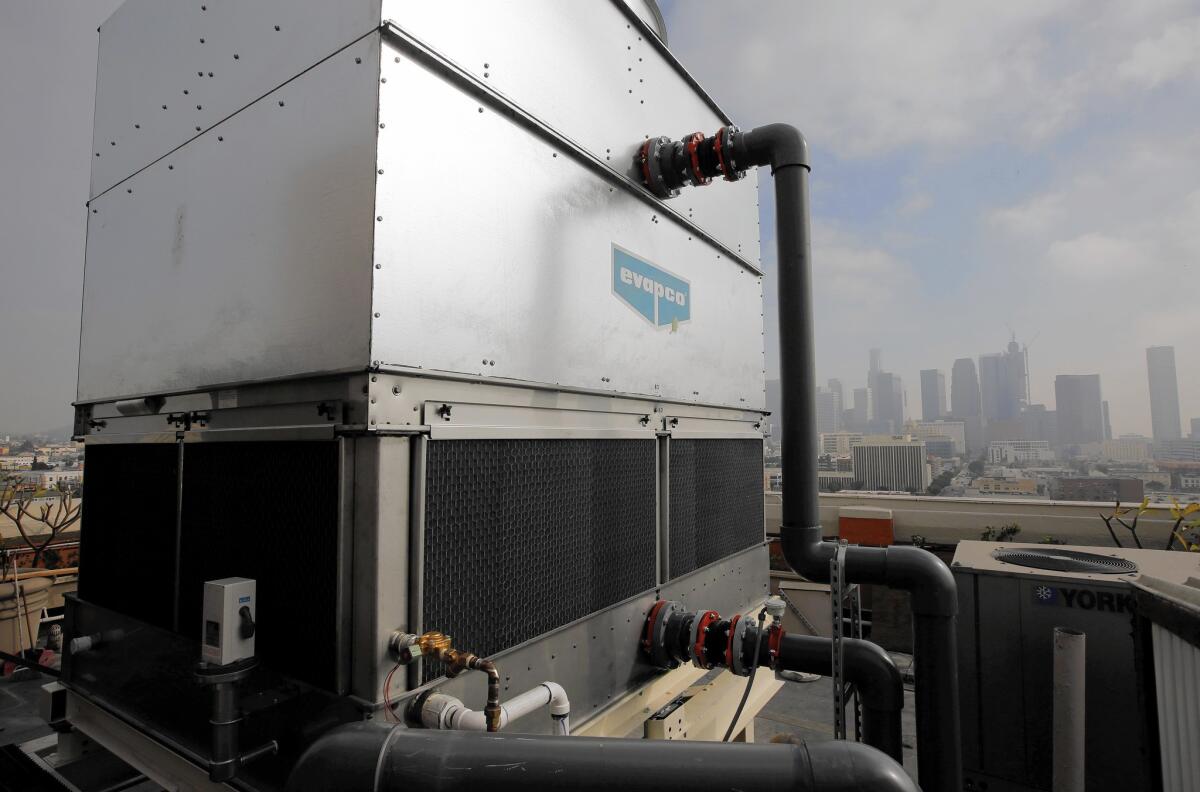High-rises harbor a little-noticed water waster: old cooling towers

On the roof of the 1950s office building on Wilshire Boulevard, a large fiberglass capsule sits silhouetted against the sky, looking more like an abandoned lunar landing module than what it really is — a giant swamp cooler.
A 6-inch pipe brings heated water to it from the 11-story building’s basement. As the water trickles through a membrane inside the chamber, a giant fan pulls air through it, removing heat by evaporation. Another pipe sends the cooled water back to the basement where it collects more of the building’s heat.
------------
FOR THE RECORD:
Cooling towers: In the Jan. 2 California section, an article about the water wasted by buildings’ old cooling systems said that more than half the water flowing through a Wilshire Boulevard evaporative cooling tower was being discarded. It should have said that in a system of its reported efficiency, more than a gallon would be discarded for every gallon evaporated.
------------
Until this fall, when the owner upgraded it, the 60-year-old equipment ran so poorly that more than half of the cooled water had to be discarded on each trip to the basement and be replaced by water from the city’s drinkable supply. It’s a hidden cycle of waste that is repeated in thousands of buildings across Los Angeles County.
Though commonly associated with massive nuclear generating plants, truck-sized cooling towers are present on almost every high-rise building because they’re better at removing large quantities of heat than the compressors used in homes. Factories, shopping malls and schools have them, too.
But most are decades old and so inefficient that they consume as much water in a day as all the bathrooms, drinking fountains and kitchens in the buildings they cool.
Now that water agencies have squeezed excess usage from their residential customers’ lawns and toilets, they are looking at the commercial and industrial sectors, which consume about a third of all the region’s water, as the next frontier of conservation.
Mayor Eric Garcetti acknowledged the potential last month by launching the Drop 100 program. Its goal is to encourage building owners to invest in upgrades that will reduce water consumption by 100 million gallons a year.
Along with water recycling and smarter irrigation, the measures could include high-efficiency lighting and windows that open to reduce cooling demand.
But the biggest potential savings would be in cooling towers, said David Hodgins, executive director of the Los Angeles Better Building Campaign, a utility-funded initiative to promote water and energy conservation in the commercial sphere.
Hodgins, whose group is spearheading the Drop 100 program, said the mayor’s goal is conservative.
Hodgins estimates that across Los Angeles County more than 2.5 billion gallons a year are wasted in cooling towers. That would be enough water to serve 15,000 households.
But it’s a guess. Information about the number and condition of cooling towers is sparse, Hodgins said. Several years ago Honeywell looked at aerial imagery to estimate that there are 5,000 to 10,000 cooling towers in Los Angeles. The Department of Water and Power is doing a new study of their efficiency that will be out this year, Hodgins said.
Because the cooling systems have long lifetimes and replacements are expensive, most owners are inclined to keep them chugging, despite the waste.
The waste comes from what is called blowdown. Evaporation in the cooling tower raises the mineral content of the remaining water, eventually making it so corrosive it must be discarded.
In an efficient system, each gallon of water can cycle through the tower five or more times before being sent down the drain. Eighty percent of the loss is due to evaporation.
The worst systems have only one cycle. The water goes through the tower once and then down the drain. Various sources suggest that the average system in Los Angeles runs at less than three cycles or even less than two, Hodgins said. At two cycles, half the water used is lost to blowdown.
Getting from two to five cycles can cut the water use by 40%, Hodgins said.
The cost can make it a hard decision.
Before its upgrade, the spherical pod on the Walter J Tower on Wilshire Boulevard at Westlake Avenue was running at 1.34 cycles, said Gregg Cummings, sustainability consultant for Talo Management Group, which represents Walter Jayasinghe, a physician who owns two Wilshire Boulevard high-rises. That meant very little water was being reused.
But the fiberglass chamber was salvageable. The upgrade included new filters, variable-speed motors that slow down when there’s less demand, high-tech monitors of the water quality and automated chemical treatment, Cummings said.
Total cost was on the low end, $35,000. When the final calibrations are made, the tower will be up to five cycles, he said.
Jayasinghe wasn’t as lucky with his second building.
Its cooling tower was of the same vintage but was more run-down because of heavier demand. Replacement was the only option. A shiny new box about the size of a delivery truck now stands on the roof, quietly removing the building’s heat. The replacement cost was about $150,000.
See more of our top stories on Facebook >>
The decision to upgrade the two units was a combination of economy and eco-consciousness, said William Lowery, president of Talo Management Group.
Faced with increasing utility costs, a historic drought and the need to stay competitive, the owner saw “a way to substantially reduce the buildings’ energy use, water consumption, and environmental impact,” Lowery said.
The project improved the work environment for tenants, reduced operating costs and enhanced asset value, he said.
Part of the cost savings comes from the DWP’s Energy Efficiency Technical Assistance Program, which pays Jayasinghe $1.75 for each 1,000 gallons saved over a five-year period.
Despite those advantages, Jayasinghe still represents a small percentage of owners.
Today, only about 10% to 20% of buildings have cooling systems that operate at the optimal level of five or six cycles, Hodgins said.
Only about 300 are known to have been upgraded.
“There’s a lot to do,” he said.
Twitter: @LATdoug
ALSO
Why the Porter Ranch gas leak could take months to fix
Venice tenants’ complaints to the city had unintended consequences
Sticker shock: Uber’s NYE surge pricing outrages some passengers
More to Read
Sign up for Essential California
The most important California stories and recommendations in your inbox every morning.
You may occasionally receive promotional content from the Los Angeles Times.











